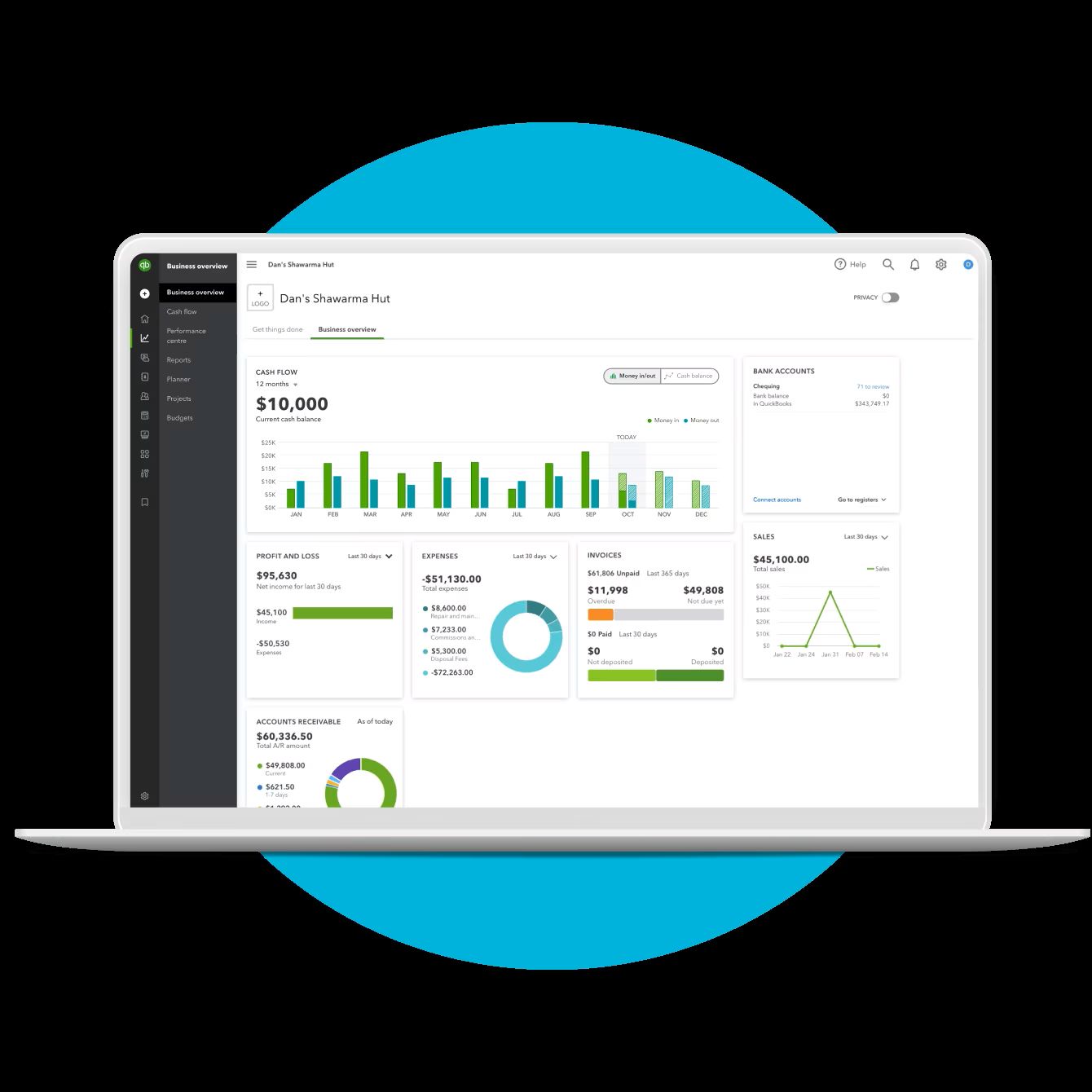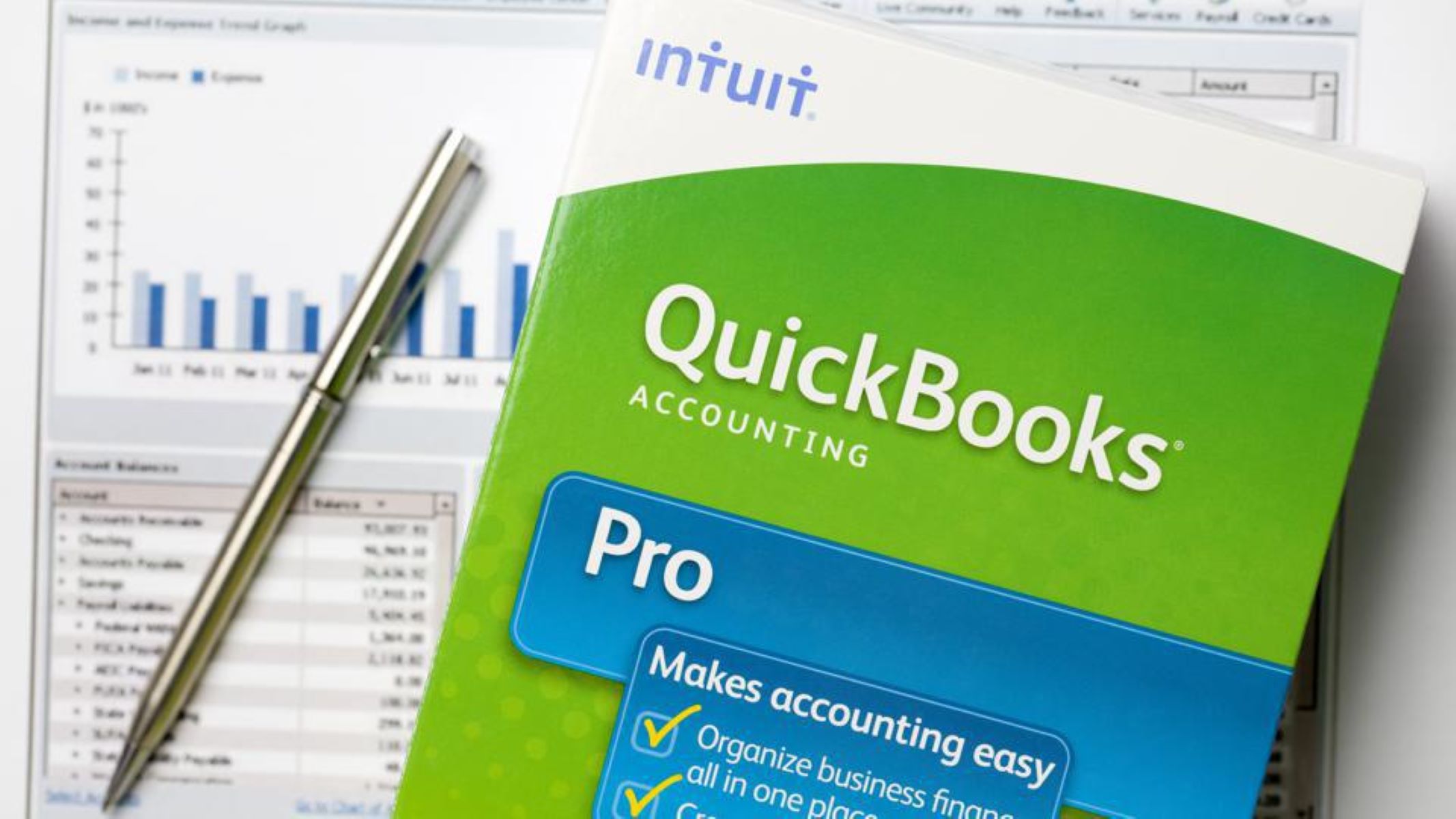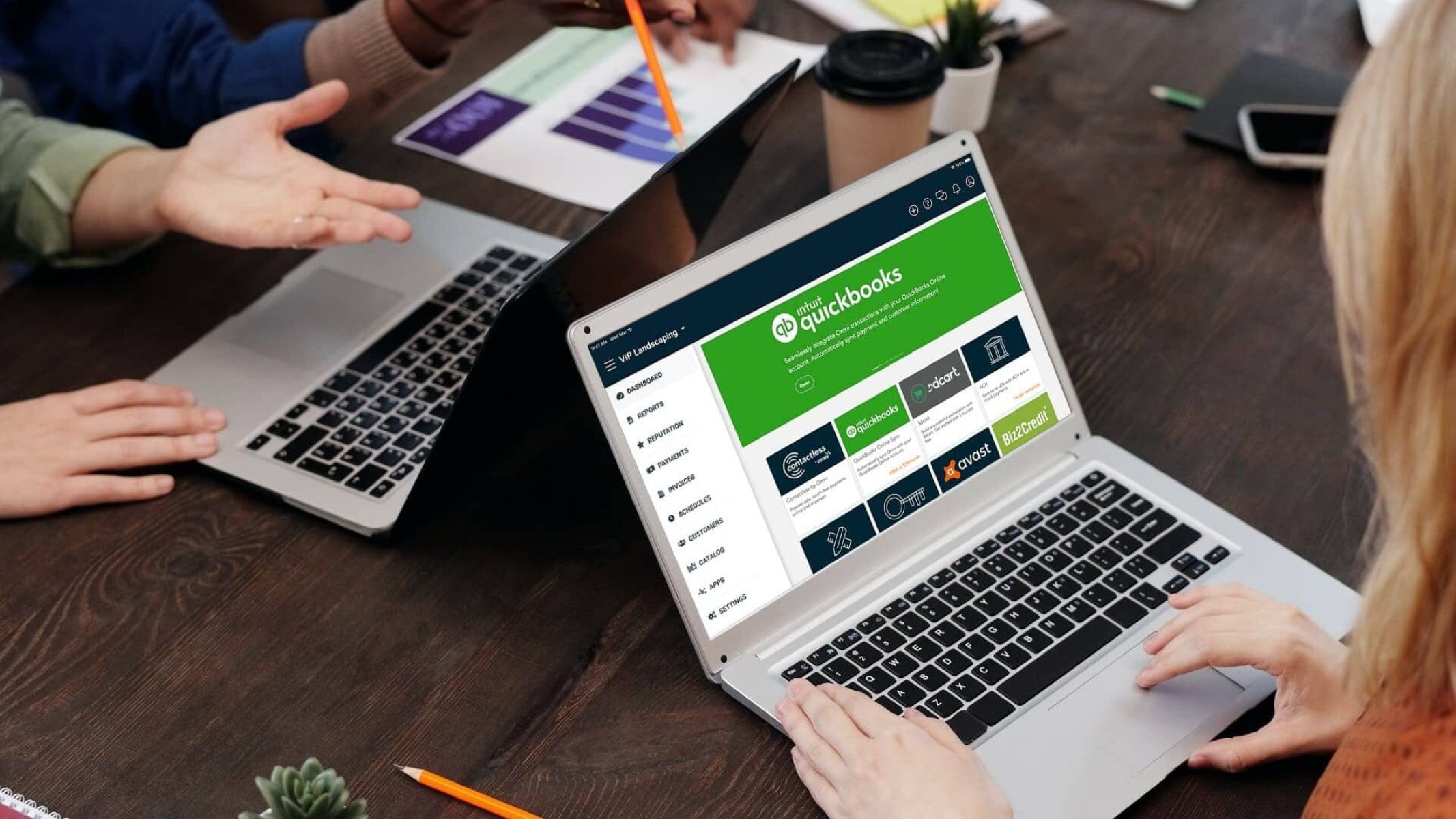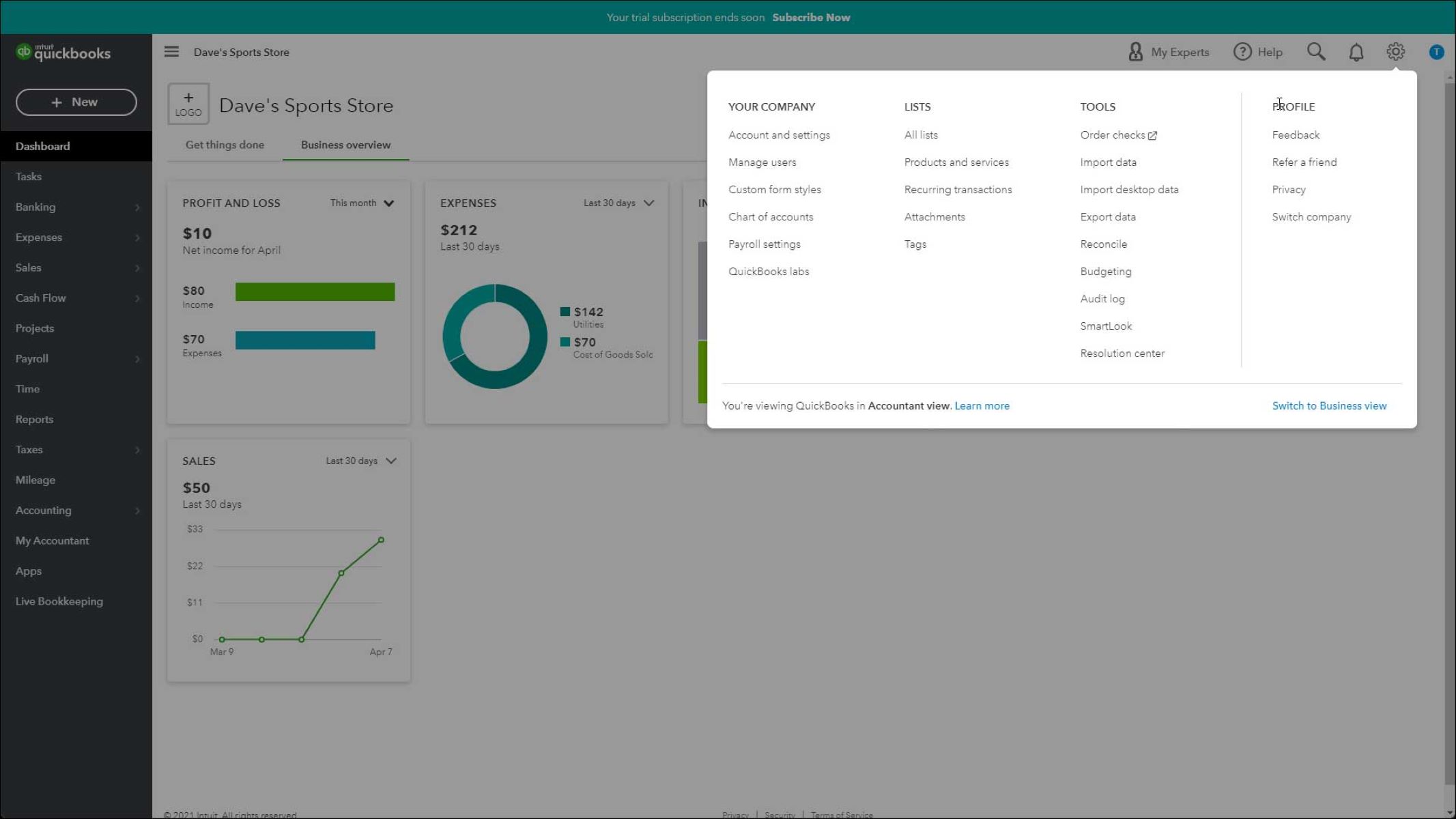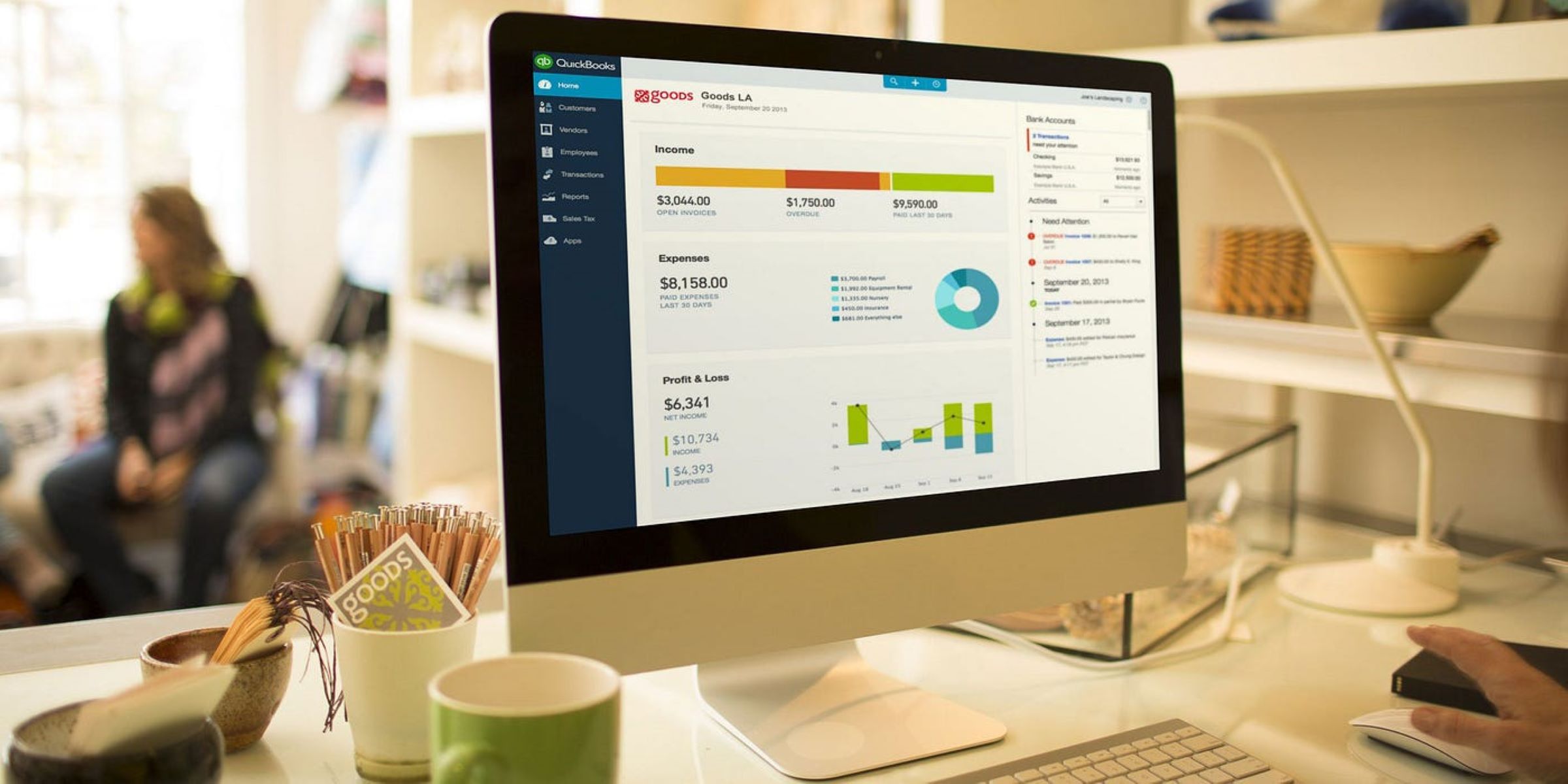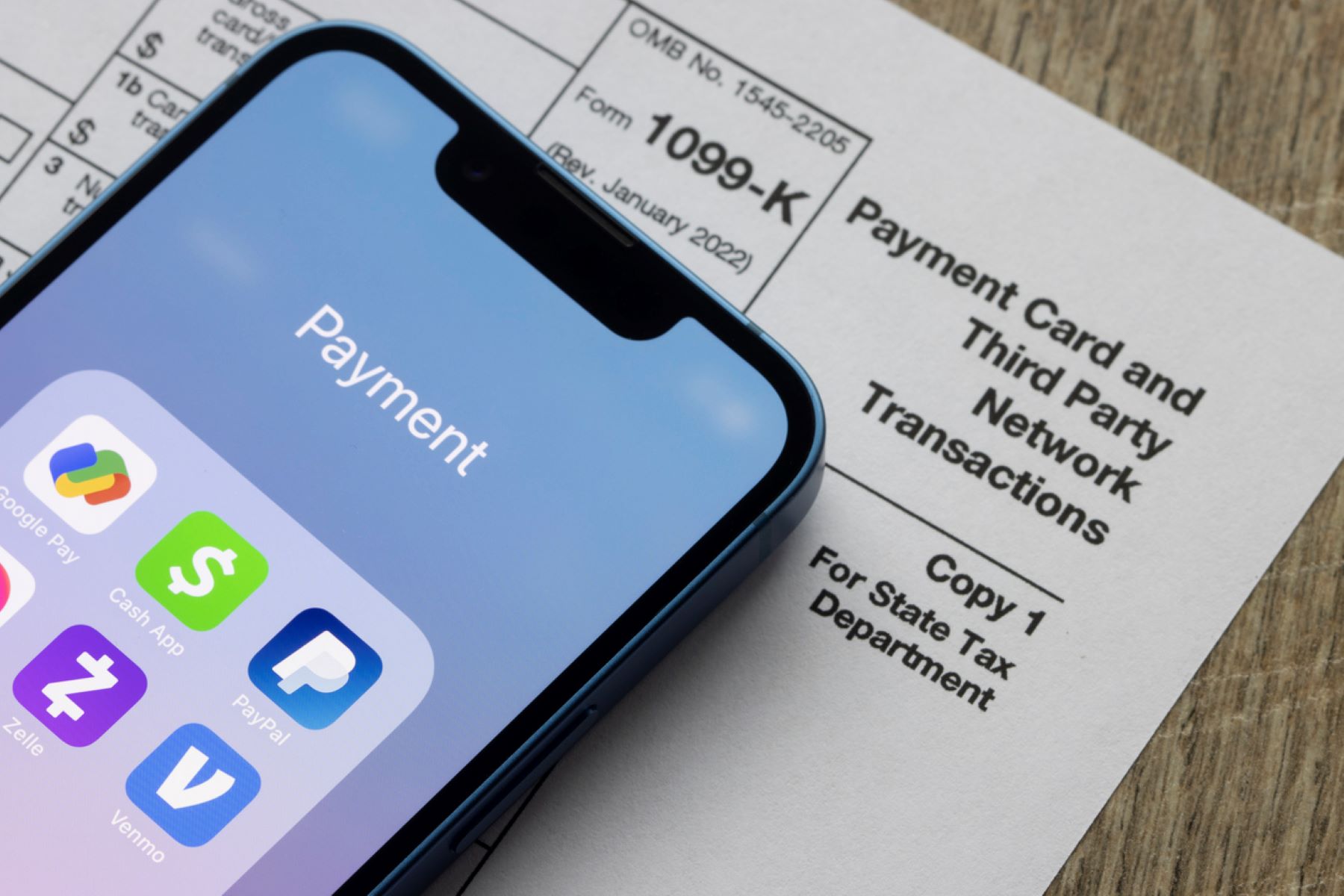Introduction
Welcome to the world of QuickBooks Desktop, the trusted accounting software that has been helping businesses of all sizes manage their finances efficiently for over three decades. Whether you’re a small business owner, self-employed professional, or an accountant looking for reliable software, QuickBooks Desktop is designed to simplify your financial tasks and keep your business on track.
With its powerful features, user-friendly interface, and robust reporting capabilities, QuickBooks Desktop has become the go-to choice for businesses to streamline their accounting processes. By automating tasks like invoicing, expense tracking, and payroll management, QuickBooks Desktop saves valuable time and reduces the risk of errors.
One of the key advantages of QuickBooks Desktop is its versatility. It caters to a wide range of industries and offers customizable options to meet unique business requirements. Whether you’re in retail, manufacturing, professional services, or any other sector, QuickBooks Desktop provides the tools you need to effectively manage your finances.
In this comprehensive guide, we will explore the various features and benefits of QuickBooks Desktop. We will also delve into the different versions of QuickBooks Desktop available, system requirements for installation, and step-by-step instructions on how to set up and navigate the software. Additionally, we will cover essential aspects such as managing sales and income, tracking expenses and purchases, payroll and employee management, generating reports, integrating with other applications, and troubleshooting common issues.
So, whether you’re new to QuickBooks Desktop or looking to enhance your knowledge and skills, this guide will serve as your comprehensive resource. Let’s dive in and discover how QuickBooks Desktop can transform the way you manage your finances and help your business thrive.
Overview of QuickBooks Desktop
QuickBooks Desktop is a robust accounting software that provides businesses with the tools they need to efficiently manage their financial operations. With a wide range of features, it allows users to track income and expenses, create invoices, manage inventory, and generate insightful reports for better decision making.
One of the key advantages of QuickBooks Desktop is its user-friendly interface. The software is designed to be intuitive and easily navigable, even for users with little or no accounting background. This makes it accessible to businesses of all sizes and ensures that users can quickly adapt to the software and start leveraging its benefits.
Another notable feature of QuickBooks Desktop is its ability to handle multiple financial tasks. From managing accounts receivable and payable to tracking inventory and payroll, QuickBooks Desktop offers comprehensive solutions that streamline the financial workflows of businesses. This allows users to save time and effort by centralizing all their financial data in one place.
QuickBooks Desktop also enables users to generate a wide variety of reports that provide meaningful insights into the financial health of their business. Whether it’s profit and loss statements, balance sheets, or cash flow statements, QuickBooks Desktop offers customizable reporting options to meet specific business needs. These reports can be generated at any time and help businesses make informed decisions for growth and profitability.
Security is a top priority when it comes to managing financial data, and QuickBooks Desktop takes this aspect seriously. The software has several built-in security features, including user permissions, data encryption, and automatic backups, to ensure that sensitive financial information remains protected at all times.
QuickBooks Desktop is also known for its flexibility and scalability. It offers different versions tailored to specific business needs, such as QuickBooks Pro, QuickBooks Premier, and QuickBooks Enterprise. This allows businesses to choose the version that best suits their requirements and upgrade as they grow.
In summary, QuickBooks Desktop is a comprehensive accounting software that offers a wide range of features and benefits for businesses. Its user-friendly interface, ability to handle multiple financial tasks, robust reporting capabilities, and focus on security make it an ideal choice for any business looking to streamline their financial management processes.
Features and Benefits of QuickBooks Desktop
QuickBooks Desktop is packed with a plethora of features that help businesses streamline their financial management processes. Let’s explore some of the key features and the benefits they offer:
- Invoicing: QuickBooks Desktop allows users to easily create and customize professional-looking invoices. This feature saves time and enhances the professional image of the business.
- Expense Tracking: Users can track and categorize expenses, making it easier to analyze spending patterns and identify areas for cost savings. This feature also ensures accurate tax preparation.
- Bank Reconciliation: QuickBooks Desktop provides a seamless bank reconciliation process, enabling users to easily match transactions and keep their financial records up-to-date.
- Inventory Management: Businesses can efficiently manage their inventory with features like tracking quantities, setting reorder points, and generating purchase orders. This helps prevent stockouts and maintain optimal inventory levels.
- Payroll Management: QuickBooks Desktop offers integrated payroll management, allowing businesses to easily calculate employee salaries, automate tax filings, and generate pay stubs.
- Customizable Reporting: Users can generate a wide range of customizable reports to gain insights into their financial performance, monitor cash flow, and make informed decisions for their business.
- Third-Party App Integration: QuickBooks Desktop seamlessly integrates with a variety of third-party applications, such as CRM systems and e-commerce platforms, to enhance efficiency and provide a holistic view of the business.
- Multi-user Collaboration: QuickBooks Desktop allows multiple users to collaborate on financial tasks simultaneously, improving efficiency and enabling real-time collaboration.
- Data Security: QuickBooks Desktop prioritizes data security with features like user permissions, data encryption, and automatic backups. This ensures that financial information remains protected and reduces the risk of data loss.
The benefits of using QuickBooks Desktop are numerous:
- Time-Saving: By automating various financial tasks, QuickBooks Desktop saves valuable time, allowing businesses to focus on core operations and strategic growth.
- Accuracy: With its robust tracking and reporting capabilities, QuickBooks Desktop helps eliminate errors and ensures accurate financial records.
- Financial Visibility: QuickBooks Desktop provides businesses with real-time insights into their financial health, enabling them to make informed decisions and identify opportunities for improvement.
- Improved Cash Flow: Efficient invoicing and receivables management features in QuickBooks Desktop help businesses get paid faster, improving cash flow and liquidity.
- Tax Compliance: QuickBooks Desktop simplifies tax preparation by automatically categorizing expenses and generating reports that facilitate easy tax filing.
- Scalability: QuickBooks Desktop offers different versions that can cater to the needs of growing businesses, allowing them to upgrade to a more robust solution as their requirements evolve.
In summary, QuickBooks Desktop offers a wide range of features and benefits that help businesses streamline their financial management processes, save time, improve accuracy, and make informed decisions for growth and profitability.
Different Versions of QuickBooks Desktop
QuickBooks Desktop offers various versions tailored to meet the specific needs of different businesses. Each version comes with its own set of features and capabilities. Let’s take a closer look at the different versions of QuickBooks Desktop:
- QuickBooks Pro: QuickBooks Pro is ideal for small businesses looking for robust accounting and financial management features. It offers capabilities such as invoicing, expense tracking, bank reconciliation, and comprehensive reporting. With the ability to track up to three users, QuickBooks Pro is suitable for small teams.
- QuickBooks Premier: QuickBooks Premier is designed for businesses that have more industry-specific needs. It includes all the features of QuickBooks Pro and offers additional industry-specific features such as advanced inventory management, job costing, and forecasting. QuickBooks Premier allows up to five users, making it suitable for growing businesses.
- QuickBooks Enterprise: QuickBooks Enterprise is the most advanced version of QuickBooks Desktop, aimed at larger businesses with complex accounting requirements. It offers advanced features such as advanced inventory management, advanced pricing, and advanced reporting. QuickBooks Enterprise supports up to 30 users, making it suitable for medium to large-sized enterprises.
- QuickBooks Accountant: QuickBooks Accountant is specifically designed for professional accountants and bookkeepers. It provides robust accounting tools, such as the ability to work with multiple company files simultaneously, streamlined client collaboration features, and advanced reporting options. QuickBooks Accountant offers industry-specific editions to cater to the needs of various industries.
Each version of QuickBooks Desktop offers scalability, allowing businesses to start with a lower-tier version and upgrade as their needs grow. This ensures that businesses can choose the version that aligns with their current requirements and easily transition to a more advanced version when needed.
Additionally, QuickBooks Desktop offers industry-specific editions within each version. These editions cater to the unique needs of different industries, such as manufacturing, retail, nonprofit, and professional services. Industry-specific editions provide tailored features and reports that are relevant to the specific industry, making it easier for businesses to manage their finances effectively.
It’s essential to consider the size and industry of your business when choosing a version of QuickBooks Desktop. Evaluating your specific requirements will help you select the version that offers the right features and capabilities to meet your accounting and financial management needs.
In summary, QuickBooks Desktop offers different versions, including QuickBooks Pro, QuickBooks Premier, QuickBooks Enterprise, and QuickBooks Accountant. Each version caters to specific business needs and industries, allowing businesses to choose the version that best aligns with their requirements.
System Requirements for QuickBooks Desktop
Before installing QuickBooks Desktop, it’s important to ensure that your computer meets the necessary system requirements to run the software smoothly. Having the right hardware and software specifications not only ensures optimal performance but also helps minimize compatibility issues. Let’s take a look at the system requirements for QuickBooks Desktop:
- Operating System: QuickBooks Desktop is compatible with various Windows operating systems, including Windows 10, Windows 8.1, Windows 7, and Windows Server 2012 R2 or later versions. It does not support Mac operating systems.
- Processor: QuickBooks Desktop requires a minimum 2.4 GHz processor, but a faster processor is recommended for better performance.
- RAM: The recommended RAM for QuickBooks Desktop is 4 GB, but for optimal performance, it is recommended to have 8 GB or more.
- Hard Disk Space: The minimum disk space required for installation is 2.5 GB, but additional space is needed for data files and backups. It is recommended to have at least 5 GB of free space.
- Display: QuickBooks Desktop requires a screen resolution of at least 1280×1024. It is also recommended to have a high-resolution monitor for better visibility and usability.
- Internet Connection: An active internet connection is required for many QuickBooks Desktop features, including online banking and payroll processing.
- Microsoft Office Compatibility: QuickBooks Desktop integrates with Microsoft Office applications such as Word, Excel, and Outlook. It requires Office 2010, 2013, 2016, or Office 365 for seamless integration.
- Additional Requirements: QuickBooks Desktop requires Adobe Acrobat Reader 11.0 or higher for printing forms and reports. It is also recommended to have a minimum screen resolution of 14 inches for better usability.
It’s important to review the system requirements before installing QuickBooks Desktop to ensure that your computer meets the specifications. Failing to meet the minimum requirements may result in slow performance, compatibility issues, or even installation failure.
If you are unsure whether your computer meets the system requirements, you can use the QuickBooks System Requirements tool available on the Intuit website. This tool will automatically scan your system and notify you if any components do not meet the recommended specifications.
In summary, QuickBooks Desktop has specific system requirements that need to be met for optimal performance. It is important to ensure that your computer meets these requirements to ensure smooth installation and operation of the software.
How to Install QuickBooks Desktop
Installing QuickBooks Desktop is a straightforward process. Follow these steps to install the software on your computer:
- Step 1: Download the Installation File: Visit the official QuickBooks website and download the installation file for the version of QuickBooks Desktop you have purchased.
- Step 2: Run the Installation File: Locate the downloaded installation file on your computer and double-click on it to run the installer.
- Step 3: Agree to the License Agreement: Read the QuickBooks license agreement and click on the “I accept the terms in the license agreement” checkbox to proceed with the installation.
- Step 4: Choose the Installation Type: Select the installation type that suits your needs. You can choose between “Express” or “Custom and Network Options”. The “Express” installation will install QuickBooks with default settings, while the “Custom and Network Options” installation allows you to customize the installation location and network settings.
- Step 5: Enter the License and Product Information: Enter the license number and product key provided with your purchase. These details are necessary to validate your installation.
- Step 6: Choose the Installation Location: Select the location on your computer where you want QuickBooks Desktop to be installed. By default, it is installed in the “C:\Program Files\Intuit” folder, but you can choose a different location if desired.
- Step 7: Begin the Installation: Click on the “Install” button to start the installation process. QuickBooks Desktop will begin installing all the necessary files on your computer.
- Step 8: Complete the Installation: Once the installation is complete, you will see a confirmation message. Click on “Open QuickBooks” to launch the software and begin the setup process for your company file.
After successfully installing QuickBooks Desktop, the software will prompt you to set up your company file and enter details such as your business name, address, and industry. This information will help customize QuickBooks according to your business requirements and preferences.
It’s worth noting that during the installation process, QuickBooks Desktop may prompt you to install important updates. It is highly recommended to install these updates as they often contain bug fixes, security patches, and feature enhancements.
In summary, installing QuickBooks Desktop involves downloading the installation file from the official website, running the installer, agreeing to the license agreement, entering the license and product information, choosing the installation type and location, and completing the installation. After installation, you can proceed with setting up your company file and customizing QuickBooks according to your business needs.
Setting Up Your Company in QuickBooks Desktop
Once you have installed QuickBooks Desktop, it’s time to set up your company file and configure the software according to your business needs. Follow these steps to set up your company in QuickBooks Desktop:
- Step 1: Create a New Company File: Launch QuickBooks Desktop and select the option to create a new company file. Follow the prompts to enter your business information, such as the business name, address, industry type, and fiscal year.
- Step 2: Customize Your Chart of Accounts: The chart of accounts is a crucial component of QuickBooks that helps categorize and track your income, expenses, assets, and liabilities. Customize your chart of accounts to align with your business structure and financial reporting requirements.
- Step 3: Set Up Your Products and Services: If you sell products or services, enter them into QuickBooks Desktop. Include details such as the item name, description, sales price, and cost of goods sold. This will help you accurately track inventory and record sales transactions.
- Step 4: Add Your Customers and Vendors: Enter your customer and vendor information into QuickBooks Desktop. Include details such as names, addresses, contact information, and payment terms. This will make it easier to track transactions with customers and vendors.
- Step 5: Set Up Bank Accounts and Credit Cards: Connect your bank accounts and credit cards to QuickBooks Desktop to enable seamless bank reconciliation. This will help you track your income and expenses more accurately.
- Step 6: Customize Preferences: QuickBooks Desktop allows you to customize various settings to align with your business preferences. Customize options such as invoicing templates, sales tax settings, payroll settings, and report preferences to meet your specific requirements.
- Step 7: Set Up Payroll (If Applicable): If you plan to use QuickBooks Desktop for payroll management, set up your payroll preferences and enter employee information. This will enable you to process payroll accurately and generate employee paychecks and tax forms.
- Step 8: Import or Enter Opening Balances: If you are transitioning to QuickBooks Desktop from another accounting software or have existing financial data, import or enter opening balances for your accounts. This will ensure that your financial records are accurate from the start.
- Step 9: Review and Test: Before fully using QuickBooks Desktop, review your setup and perform test transactions to ensure that everything is working as expected. This will help identify any setup errors or issues that need to be resolved.
It’s important to note that the setup process may vary depending on the version and edition of QuickBooks Desktop you are using. QuickBooks provides step-by-step guidance and tutorials to assist you in setting up your company file.
If you encounter any difficulties during the setup process, QuickBooks Desktop offers comprehensive help resources, including online guides, support articles, and customer support options, to address your queries and provide assistance.
In summary, setting up your company in QuickBooks Desktop involves creating a new company file, customizing the chart of accounts, adding products and services, entering customer and vendor information, setting up bank accounts and credit cards, customizing preferences, setting up payroll (if applicable), importing or entering opening balances, and reviewing and testing your setup. Taking the time to set up QuickBooks Desktop correctly will lay the foundation for accurate financial management and reporting.
Navigating the QuickBooks Desktop Interface
Navigating the QuickBooks Desktop interface is crucial to efficiently manage your financial tasks and access the various features and functionalities. Familiarizing yourself with the different sections and tools within QuickBooks Desktop will help you navigate the software effectively. Here’s a guide to help you navigate the QuickBooks Desktop interface:
- Homepage: The QuickBooks Desktop homepage is the hub where you can access key features and tasks. It provides an overview of your business finances, including account balances, recent transactions, and important reminders. From the homepage, you can access features such as creating invoices, recording expenses, and running reports.
- Menu Bar: The menu bar at the top of the QuickBooks Desktop window contains various menus, including File, Edit, View, Lists, Customers, Vendors, Employees, Banking, Reports, and Help. Each menu contains a dropdown list of related tasks and features. Use the menu bar to navigate through different sections of the software.
- Icon Bar: The icon bar is located on the left side of the QuickBooks Desktop window and provides quick access to commonly used features and tasks. You can customize the icon bar to include shortcuts to the features you use most frequently, such as creating invoices, recording expenses, and running reports.
- Centers: QuickBooks Desktop contains different centers that allow you to manage specific aspects of your business, such as the Customer Center, Vendor Center, Employee Center, and Report Center. These centers provide a centralized location to view and manage related information. For example, the Customer Center allows you to view customer transactions, send invoices, and manage customer details.
- Forms and Transactions: QuickBooks Desktop uses various forms and transaction windows to enter and manage financial data. Examples of common forms include invoices, bills, purchase orders, and checks. To access these forms, navigate through the appropriate menu or center and select the desired form.
- Registers and Lists: QuickBooks Desktop utilizes registers and lists to manage specific types of financial data. Registers, such as the check register and deposit register, allow you to manually enter and view transactions. Lists, such as the Chart of Accounts and Item List, provide a comprehensive view of financial entities and can be customized to suit your business needs.
- Reports: QuickBooks Desktop offers a wide range of pre-built reports that provide insights into your business finances. You can access these reports through the Reports menu or the Report Center. Reports can be customized by selecting the desired options, such as date range, filters, and columns.
- Search Function: QuickBooks Desktop includes a search function that allows you to find specific transactions, accounts, customers, vendors, and other records quickly. Use the search box at the top-right corner of the QuickBooks Desktop window to search for specific information.
- Help and Support: QuickBooks Desktop provides a comprehensive help system that includes searchable help articles, tutorials, and video guides. You can access the Help menu or press F1 to open the Help window and find answers to your questions or watch step-by-step tutorials.
It’s essential to explore and familiarize yourself with the various sections and tools within the QuickBooks Desktop interface. The more comfortable you become with navigating the software, the more efficiently you can manage your finances and leverage the features provided.
In summary, the QuickBooks Desktop interface consists of the homepage, menu bar, icon bar, centers, forms and transactions, registers and lists, reports, search function, and help and support resources. Understanding and utilizing these components will help you navigate through QuickBooks Desktop and efficiently manage your financial tasks.
Managing Sales and Income in QuickBooks Desktop
Managing sales and income is a crucial aspect of financial management for any business, and QuickBooks Desktop provides robust tools to help streamline and track these processes. With the right features and workflows, you can efficiently manage your sales, track income, and ensure accurate financial records. Here’s a guide to managing sales and income in QuickBooks Desktop:
- Creating Invoices: QuickBooks Desktop allows you to create professional invoices to bill your customers for products or services rendered. Simply select the “Create Invoices” option and enter the customer details, items sold, quantities, and any applicable discounts or taxes. You can customize the invoice template and send it to the customer via email or print a hard copy.
- Managing Customer Payments: When customers make payments against their invoices, you can record these payments in QuickBooks Desktop. You can choose to receive payments in various forms such as cash, check, credit card, or electronic payments. QuickBooks will automatically update the invoice and mark it as paid, keeping your accounts receivable up-to-date.
- Tracking Sales Orders: If your business deals with sales orders before creating an invoice, QuickBooks Desktop allows you to track and manage these orders. You can create sales orders, track their status, and convert them into invoices once fulfilled.
- Managing Sales Receipts: For businesses that receive immediate payments for goods or services at the time of sale, QuickBooks Desktop offers the option to create sales receipts. Sales receipts are used to record cash or check payments immediately when the sale occurs, bypassing the invoice step.
- Automating Recurring Invoices: If you have customers on recurring billing cycles, QuickBooks Desktop allows you to set up automated recurring invoices. This feature saves time by automatically generating and sending invoices at specified intervals.
- Applying Discounts and Credits: QuickBooks Desktop enables you to apply discounts, credits, or promotions to customer invoices. This helps ensure accurate billing and maintains good relationships with your customers.
- Using Sales Reports: QuickBooks Desktop offers a wide range of sales reports that provide insights into your business finances. From sales by customer to profit and loss by product or service, these reports help you analyze sales performance, identify trends, and make informed business decisions.
- Integration with Payment Processors: QuickBooks Desktop integrates with various payment processors, allowing you to accept credit card and electronic payments directly within the software. This streamlines the payment process and improves cash flow.
By effectively managing sales and income in QuickBooks Desktop, you can ensure accurate financial records, streamline billing processes, improve cash flow, and gain valuable insights into your business performance. With the right tools and workflows, QuickBooks Desktop empowers you to efficiently manage your sales transactions and track your income with ease.
In summary, QuickBooks Desktop provides a range of features and tools to manage sales and income effectively. By creating invoices, tracking customer payments, managing sales orders, automating recurring invoices, and utilizing sales reports, you can streamline your sales processes and track your income accurately in QuickBooks Desktop.
Tracking Expenses and Purchases in QuickBooks Desktop
Tracking expenses and purchases is a critical aspect of financial management for any business, and QuickBooks Desktop offers powerful tools to simplify and streamline this process. By effectively tracking your expenses and purchases, you can maintain accurate financial records, analyze spending patterns, and make informed business decisions. Here’s a guide to tracking expenses and purchases in QuickBooks Desktop:
- Entering Expenses: QuickBooks Desktop allows you to enter expenses manually or import them from bank or credit card transactions. You can record various types of expenses, including utility bills, rent payments, office supplies, and travel expenses. Simply enter the expense information, assign the appropriate expense category, and save the transaction.
- Managing Vendor Bills: If you receive bills from vendors, QuickBooks Desktop enables you to enter and track these bills. You can record details such as the vendor name, invoice number, and due date. QuickBooks will track outstanding bills and provide reminders to ensure timely payments.
- Tracking Business Purchases: QuickBooks Desktop allows you to record business purchases, such as equipment, inventory, or other assets. You can assign the appropriate asset or expense account, enter the purchase details, and track the cost and depreciation over time.
- Reconciling Bank and Credit Card Transactions: QuickBooks Desktop offers a bank reconciliation feature that allows you to match your recorded expenses and purchases with your bank and credit card transactions. This ensures that your financial records are accurate and up-to-date.
- Managing Bill Payments: QuickBooks Desktop allows you to record and manage bill payments. You can easily track payments made to vendors and link them to the corresponding vendor bills or expenses. This ensures that your accounts payable records are accurate.
- Tracking Project Expenses: If your business undertakes projects or jobs, QuickBooks Desktop offers the ability to track project expenses. This feature allows you to associate expenses with specific projects or jobs, helping you monitor project profitability and budget adherence.
- Expense Reports: QuickBooks Desktop enables you to generate expense reports, providing a comprehensive view of your business expenses. These reports allow you to analyze spending patterns, identify cost-saving opportunities, and ensure compliance with expense policies.
- Integration with Receipt Scanning Tools: QuickBooks Desktop integrates with receipt scanning tools, allowing you to digitize and store receipts electronically. This simplifies expense tracking and ensures that you have a record of all transactions, even for cash-based purchases.
- Tracking Sales Tax: QuickBooks Desktop provides features to help you accurately track sales tax. You can set up sales tax items, assess sales tax on customer invoices, and generate reports to facilitate sales tax filing.
By effectively tracking expenses and purchases in QuickBooks Desktop, you can maintain accurate financial records, identify cost-saving opportunities, and make informed business decisions. The robust features and tools provided by QuickBooks Desktop streamline the expense tracking process, improve financial transparency, and help you stay on top of your business finances.
In summary, QuickBooks Desktop offers a range of features and tools to track expenses and purchases efficiently. By entering expenses, managing vendor bills, tracking business purchases, reconciling bank and credit card transactions, managing bill payments, generating expense reports, integrating with receipt scanning tools, and tracking sales tax, you can maintain accurate financial records and gain valuable insights into your business’s spending.
Payroll and Employee Management in QuickBooks Desktop
Efficient payroll and employee management are essential for businesses of all sizes, and QuickBooks Desktop offers robust tools to simplify these processes. By leveraging QuickBooks Desktop’s payroll and employee management features, you can accurately process employee payroll, manage employee data, track time, and comply with payroll tax regulations. Here’s a guide to payroll and employee management in QuickBooks Desktop:
- Payroll Setup: QuickBooks Desktop guides you through the payroll setup process. You can enter employee information, such as names, addresses, social security numbers, and tax withholding details. Additionally, you can set up payroll schedules, employee deductions, and company contributions.
- Running Payroll: QuickBooks Desktop provides a comprehensive payroll processing feature. You can quickly calculate employee salaries, deduct taxes and other withholdings, and generate pay stubs. QuickBooks Desktop automatically calculates payroll taxes based on the latest tax rates and updates.
- Direct Deposit: QuickBooks Desktop offers direct deposit functionality, allowing you to pay employees electronically. You can securely transmit employee paychecks directly to their bank accounts, eliminating the need for paper checks and simplifying the payment process.
- Employee Benefits and Deductions: QuickBooks Desktop allows you to manage employee benefits, deductions, and contributions. You can set up retirement plans, healthcare benefits, and other employee deductions, ensuring accurate and automated calculations in each payroll run.
- Employee Time Tracking: QuickBooks Desktop provides tools for tracking employee time. You can enter employee hours worked, track vacation and sick leave hours, and calculate overtime. This information seamlessly integrates into the payroll process.
- Employee Self-Service Portal: QuickBooks Desktop offers an employee self-service portal where employees can access their pay stubs, view tax forms, update personal information, and submit time-off requests. This enhances employee engagement and minimizes administrative work.
- Payroll Tax Compliance: QuickBooks Desktop helps ensure payroll tax compliance. It automatically calculates federal and state payroll taxes, generates tax forms, and provides reminders for tax filing deadlines. This helps businesses avoid costly penalties and simplifies tax preparation.
- New Hire Reporting: When hiring new employees, QuickBooks Desktop assists with new hire reporting requirements. It generates the necessary forms required by the state, making it easy to comply with reporting regulations.
- Payroll Reports: QuickBooks Desktop provides a variety of payroll reports, including wage and tax summaries, employee earnings reports, and payroll tax liability reports. These reports offer insights into payroll costs and tax liabilities, enabling better financial management.
By leveraging QuickBooks Desktop for payroll and employee management, businesses can streamline their payroll processes, ensure accurate and timely payments to employees, and comply with payroll tax regulations. The comprehensive features for payroll setup, direct deposit, employee benefits and deductions, time tracking, employee self-service, and payroll tax compliance provided by QuickBooks Desktop simplify the complexities associated with managing payroll and streamline employee management.
In summary, QuickBooks Desktop offers a range of features and tools to effectively manage payroll and employee information. By setting up payroll, running payroll efficiently, managing employee benefits and deductions, utilizing employee time tracking, providing an employee self-service portal, ensuring payroll tax compliance, and utilizing payroll reports, businesses can streamline payroll processes and effectively manage employee data.
Generating Reports in QuickBooks Desktop
Generating reports is a crucial aspect of financial management for businesses, as it provides valuable insights into the financial health and performance of the company. QuickBooks Desktop offers a wide array of pre-built reports that can be easily generated, customized, and analyzed. Here’s a guide to generating reports in QuickBooks Desktop:
- Report Center: QuickBooks Desktop provides a centralized location called the Report Center where you can access a variety of reports. Simply navigate to the Reports menu or click on the Report Center icon in the toolbar to access the extensive list of available reports.
- Report Categories: Reports in QuickBooks Desktop are organized into different categories, such as Company and Financial, Customers and Receivables, Vendors and Payables, Sales, Inventory, Time and Mileage, Banking, Payroll, and more. This categorization makes it easy to find the specific report you need.
- Report Customization: QuickBooks Desktop allows you to customize reports to meet your specific needs. You can modify the date range, filter the data, rearrange and add new columns, and even change the fonts and colors. Customization options allow you to tailor the reports to provide the exact information you require.
- Saved Custom Reports: QuickBooks Desktop gives you the ability to save customized reports for future use. This feature ensures that reports can be easily accessed and generated on an ongoing basis, saving time and effort in recreating them each time.
- Report Memorization: QuickBooks Desktop enables you to memorize reports with specific settings. Memorization allows you to schedule reports to run automatically at specified intervals and be delivered to your preferred location, such as your email inbox.
- Report Export and Sharing: QuickBooks Desktop provides options to export reports to various formats, including PDF, Excel, and CSV. This allows you to easily share reports with others or use the data for further analysis or presentations.
- Commonly Used Reports: QuickBooks Desktop offers a set of commonly used reports that provide insights into key aspects of your business, such as profit and loss statements, balance sheets, cash flow reports, accounts receivable aging, accounts payable aging, and sales reports. These reports offer a snapshot of your financial performance.
- Industry-Specific Reports: Depending on your industry, QuickBooks Desktop provides industry-specific reports. These reports cater to the unique needs and requirements of specific industries, providing insights and analysis pertinent to your business niche.
- Managing Multiple Company Reports: If you manage multiple companies in QuickBooks Desktop, you can generate reports for each company individually. QuickBooks Desktop allows you to switch between companies and access the reports specific to each business entity.
By leveraging the reporting capabilities of QuickBooks Desktop, businesses can gain valuable insights into their financial performance, track key metrics, and make informed decisions. The flexibility and customization options available in QuickBooks Desktop reports allow businesses to analyze data in a way that is relevant and meaningful to their specific needs.
In summary, QuickBooks Desktop offers a wide range of reports organized into various categories. By accessing the Report Center, customizing reports, saving custom settings, scheduling automatic report generation, exporting reports, and leveraging commonly used and industry-specific reports, businesses can effectively generate reports that provide valuable insights into their financial health and performance.
Integrating QuickBooks Desktop with Other Applications
Integrating QuickBooks Desktop with other applications can enhance the efficiency and effectiveness of your business processes by allowing seamless data transfer and streamlining workflows. Whether it’s syncing data with CRM systems, e-commerce platforms, or payment processors, integrating QuickBooks Desktop with other applications can help you save time, reduce errors, and gain a comprehensive view of your business. Here’s a guide to integrating QuickBooks Desktop with other applications:
- CRM Integration: Integrating QuickBooks Desktop with your Customer Relationship Management (CRM) system allows you to maintain consistent and up-to-date customer information across platforms. This integration streamlines communication, improves customer relationships, and enhances sales and marketing efforts.
- E-commerce Integration: If you have an online store on an e-commerce platform, integrating QuickBooks Desktop allows for seamless syncing of sales and inventory data. This integration eliminates manual data entry, provides real-time inventory updates, and simplifies order management.
- Payment Processor Integration: Integrating QuickBooks Desktop with your preferred payment processor enables automatic payment synchronization. This integration saves time by automatically recording payments in QuickBooks, keeping your financial records up-to-date, and simplifying the reconciliation process.
- Expense Management Integration: By integrating QuickBooks Desktop with expense management applications, you can automate the capture and categorization of expenses. This streamlines the expense reporting process, ensures accurate record-keeping, and simplifies reimbursement for employees.
- Time Tracking Integration: Integrating QuickBooks Desktop with time tracking applications allows you to accurately capture employee hours and automatically sync them with payroll. This integration simplifies payroll processing, reduces errors, and improves workforce management.
- Reporting and Business Intelligence Integration: Integrating QuickBooks Desktop with reporting and business intelligence tools allows for more robust analysis and visualization of financial data. This integration provides deeper insights into your business’s financial performance and facilitates better decision-making.
- Document Management Integration: QuickBooks Desktop can be integrated with document management systems, enabling easy access to important financial documents. This integration simplifies document storage, retrieval, and management, allowing for a more organized and streamlined approach.
- Payroll Service Integration: If you outsource your payroll processing, integrating QuickBooks Desktop with a payroll service provider allows for seamless transfer of payroll data. This integration ensures accurate payroll calculation and simplifies the tax filing process.
- Custom Integration: QuickBooks Desktop provides developers with APIs and development tools to create custom integrations with other applications specific to your business needs. This allows for tailored solutions that enhance workflow efficiency and data synchronization.
Integrating QuickBooks Desktop with other applications offers numerous benefits, including reduced manual data entry, improved data accuracy, streamlined processes, and improved collaboration. When considering integrations, it’s essential to assess your business requirements, select reputable and compatible applications, and ensure proper implementation and ongoing support.
In summary, integrating QuickBooks Desktop with other applications enhances operational efficiency, improves data accuracy, and provides a holistic view of your business. By integrating with CRM systems, e-commerce platforms, payment processors, expense management applications, time tracking systems, reporting and business intelligence tools, document management systems, payroll service providers, or custom integrations, businesses can optimize their workflows and benefit from a seamless exchange of information.
Troubleshooting Common Issues in QuickBooks Desktop
While QuickBooks Desktop is a robust and reliable accounting software, occasional issues or errors may arise. Being familiar with common problems and their troubleshooting steps can help you resolve issues quickly and keep your financial management processes running smoothly. Here’s a guide to troubleshooting common issues in QuickBooks Desktop:
- Installation and Update Issues: If you encounter issues during installation or updating QuickBooks Desktop, ensure that you have met the necessary system requirements and that your internet connection is stable. Manually installing updates or running the QuickBooks Install Diagnostic Tool may resolve installation or update-related problems.
- Performance Issues: If QuickBooks Desktop is running slow or freezing, check if your computer meets the recommended system requirements. Clearing temporary files and optimizing your company file can also improve performance. Running the QuickBooks File Doctor tool can help repair data file issues that may be impacting performance.
- File Corruption: In the event of file corruption, run the QuickBooks File Doctor or Rebuild Data utility to fix any data-related issues. Regularly creating backups of your company file can prevent loss of data in case of file corruption.
- Bank Feeds Issues: When encountering bank feed issues, ensure that your financial institution supports the bank feeds feature. Verify your bank connection settings, disable any firewall or antivirus blocking access, and update your QuickBooks Desktop to the latest release. If the problem persists, contact your financial institution for assistance.
- Tax Calculation Issues: If you experience incorrect tax calculations, verify that your payroll tax tables are up to date. Update your tax table version and run payroll updates to ensure accurate tax calculations. If the problem persists, consult with a tax professional to ensure your tax settings are configured correctly.
- Printing Issues: When encountering printing problems, ensure that your printer is properly connected and configured. Check that the correct printer is selected within QuickBooks Desktop. Updating printer drivers or restarting the print spooler may resolve printing issues.
- Bank Reconciliation Issues: If you encounter challenges during bank reconciliation, verify that the transactions in QuickBooks match your bank statement. Check for any duplicate or missing transactions. Running the Reconcile Discrepancy tool can help identify and resolve discrepancies.
- Unrecoverable Errors: Unrecoverable errors can occur due to various reasons. Utilize the QuickBooks File Doctor tool to repair damaged company files. If the error persists, restore from a recent backup or seek assistance from QuickBooks support.
- User Access and Permissions Issues: If users are experiencing access or permission issues, ensure that they have the correct user roles and permissions assigned. Check that the user login credentials are accurate. Adjusting user roles and permissions within QuickBooks Desktop can address access issues.
When troubleshooting issues in QuickBooks Desktop, it is important to stay up to date with the latest software releases and regularly backup your data. Consulting the official QuickBooks support website, user forums, or contacting technical support directly can provide additional guidance and assistance with more complex issues.
In summary, familiarity with common issues in QuickBooks Desktop and their corresponding troubleshooting steps can help you resolve problems efficiently. From installation and update issues to performance problems, bank feed challenges, and tax calculation errors, troubleshooting common issues ensures that QuickBooks Desktop runs smoothly and effectively supports your financial management processes.
Conclusion
QuickBooks Desktop is a powerful accounting software that offers a range of features and tools to help businesses efficiently manage their financial operations. From tracking income and expenses to managing payroll and generating insightful reports, QuickBooks Desktop simplifies essential financial tasks and provides valuable insights to support informed decision-making.
In this comprehensive guide, we have explored various aspects of QuickBooks Desktop, including an overview of its features and benefits, the different versions available, system requirements for installation, setting up your company file, navigating the interface, managing sales and income, tracking expenses and purchases, payroll and employee management, generating reports, integrating with other applications, and troubleshooting common issues.
By following the guidelines and utilizing the features of QuickBooks Desktop, businesses can streamline their financial management processes, save time and effort, reduce errors, and gain accurate insights into their financial health. Whether you’re a small business owner, self-employed professional, or an accountant, QuickBooks Desktop provides the tools and functionalities to meet your specific needs.
Remember to regularly update your QuickBooks Desktop software and follow best practices for data backup to ensure data integrity and security. Additionally, leverage the resources provided by QuickBooks support, user forums, and official documentation whenever you encounter challenges or need assistance.
With its user-friendly interface, robust features, and integration capabilities, QuickBooks Desktop empowers businesses to focus on their core operations while efficiently managing their finances. Whether you’re just starting with QuickBooks Desktop or looking to enhance your knowledge and skills, this guide serves as a comprehensive resource to help you make the most out of QuickBooks Desktop and achieve financial success.







